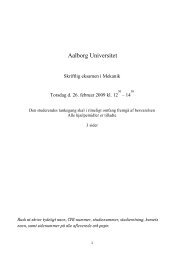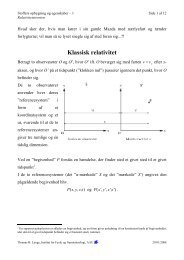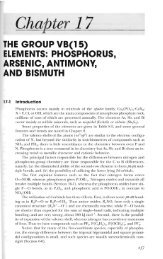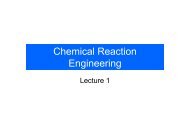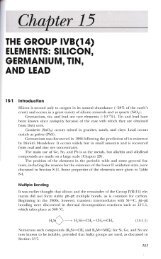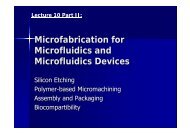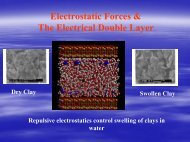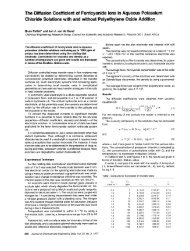Create successful ePaper yourself
Turn your PDF publications into a flip-book with our unique Google optimized e-Paper software.
<strong>Chapter</strong> <strong>21</strong><strong>THE</strong> <strong>NOBLE</strong> <strong>GASES</strong><strong>21</strong>-1 Occurrence, Isolation, and ApplicationsThe noble gases (Table <strong>21</strong>-1) are minor constituents of the atmosphere, fromwhich Sir William Ramsay was first able to isolate the elements Ne, Ar, Kr, andXe. William F. Hillebrand had isolated helium gas from uranium minerals, andRamsay was able to demonstrate that the gas has the same spectrum as the elementidentified spectroscopically in the sun by SirJ. orman Lockyer and Sir E.Frankland in 1868.Helium occurs in radioactive minerals and, notably, in some natural gases inthe United States. Its origin is entirely from the decay of uranium or thorium isotopesthat emit a-particles. These a-particles are helium nuclei that acquire electronsfrom surrounding elements, and if the rock is sufficiently impermeable,the helium remains trapped. The gas radon, all ofwhose isotopes are radioactivewith short half-lives, was characterized in the decay series from uranium and thorium.The elements Ne, Ar, Kr, and Xe are obtained from fractionation of liquidair. The gases were originally termed inert, and thought to have no chemical reactivityat all. They provided the key to the problem ofvalency, the interpretationof the periodic table, and the concept of the closed-electron shell configuration.Although we now know that some of the noble gases can form compounds, theystill provide a point of reference in these respects.A main use of helium is as the liquid in cryoscopy. Argon may be used to providean inert atmosphere in laboratory apparatus, in welding, and in gas-filledelectric light bulbs. Neon is used for discharge lighting tubes, giving the familiarred glow of "neon" signs.Radon, formed from other elements by radioactive decay sequences, is ahealth hazard in houses in certain granite areas. It is taken into the lungs, whereby-products from its decay sequences cause cancer. Thorough ventilation of thehouses is important in such areas.<strong>21</strong>-2 The Chemistry of XenonDuring studies with the very reactive gas PtF 6 , Bartlett found that a crystallinesolid, [02+][PtF6"], was formed with oxygen. He noted that since the ionizationenthalpy of Xe is almost identical with that of 02' an analogous reaction mightbe expected and, indeed, in 1962 he reported the first compound containing anoble gas, a red crystalline solid first believed to be [Xe+] [PtF6"], but now knownto be more complex.483
486 <strong>Chapter</strong> <strong>21</strong> I The Noble Gasesmade up of XeF; units linked by unsymmetrical and bent F- bridges, as shownin Fig. <strong>21</strong>-1. Monomeric XeF 6 in the liquid or the vapor has a distorted octahedralstructure because of a lone pair of electrons at Xe.Xenon Fluoride ComplexesThe xenon fluorides will react with strong Lewis acids such as SbFs or 1rFs to giveadducts. The three types of adducts formed by XeF 2 are XeF 2 ' MFs, 2XeF 2 ' MFs'and XeF 2 '2MFs, where M = Ru, Ir, Pt, and so on. Although XeF 2 '1Fs has a molecularrather than ionic structure, in most cases adduct formation involves fluorideion transfer to give structures that contain ions, such as XeF+ (formed byloss ofF- from XeF 2 ) , Xe 2 F; (which has a planar Structure <strong>21</strong>-1),FF 2.14A,/"'-..../"'-...Xe 151 Xe 1.90 A0,/" "'-...<strong>21</strong>-1and XeF; (formed by transfer of F- from XeF 6 ). Examples include[XeF;][PtF6] and Reaction <strong>21</strong>-2.7.F(<strong>21</strong>-2.7)Xenon hexafluoride can act as a Lewis acid toward F- and can be converted toheptafluoro or octafluoro xenates as in Reactions <strong>21</strong>-2.8 and <strong>21</strong>-2.9.(a)(b)Figure <strong>21</strong>-1 The tetrameric (a) and the hexameric (b) units that make up the crystal structureof XeF 6 . Each is built up of XeF; units bridged by F- ions. There are at least four crystallineforms of the substance, three of which are built up of tetramers and one which includes bothtetramers and hexamers.
<strong>21</strong>-2 The Chemistry of Xenon 487XeF 6 + RbF -----+ RbXeF 7 (<strong>21</strong>-2.8)2 RbXeF7 -----+ XeF6 + Rb 2 XeF8 (<strong>21</strong>-2.9)These rubidium octafluoroxenates are among the most stable xenon compoundsknown and decompose only above 400°C.Xenon-Oxygen CompoundsXenon trioxide is formed in the hydrolysis of XeF 4 and XeF 6 according toReactions <strong>21</strong>-2.10 and <strong>21</strong>-2.11.3 XeF 4 + 6 H 2 0 -----+ XeOs + 2 Xe +! O 2 + 12 HF (<strong>21</strong>-2.10)XeF 6 + 3 H 2 0 -----+ XeOs + 6 HF (<strong>21</strong>-2.11)The colorless, odorless, and stable aqueous solutions of XeOs appear to containXeOs molecules. On evaporation of water, XeOs is obtained as a white deliquescentsolid that is dangerously explosive. In basic solution, a xenate(Vl)ion (HXeOi) is formed, as in Reaction <strong>21</strong>-2.12.(<strong>21</strong>-2.12)The ion HXeOi slowly disproportionates to give a xenate(VlII) (or perxenateion, XeOt-), as in Reaction <strong>21</strong>-2.13.(<strong>21</strong>-2.13)Perxenates are also formed by oxidation of HXe04 with ozone. The perxenateions are yellow and are both powerful and rapid oxidizing agents. Salts such asNa 4 Xe0 6 "8H 2 0 are stable and sparingly soluble in water.In alkaline solution, the main form is the ion HXeO~-, and perxenates areonly slowly reduced by water. However, in acid solution, reduction by water accordingto Reaction <strong>21</strong>-2.14 is almost instantaneous, and the hydroxyl radical isinvolved as an intermediate.(<strong>21</strong>-2.14)When barium perxenate is heated with concentrated sulfuric acid, xenontetroxide (Xe0 4 ) is formed as an explosive and unstable gas.The aqueous chemistry of xenon is summarized by the potentials:Acid solution H 4 Xe0 62.36 V) XeO s2.12VXeF 22.64 VAlkaline solution HXeO~- 0.94 V )HXeO~1.26 V) Xe)Xe)Xe
488 <strong>Chapter</strong> <strong>21</strong> I The Noble Gases<strong>21</strong>·3 Other Noble Gas ChemistryRadon might be expected to display even more chemistry than xenon, but becauseof the radioactivity of all radon isotopes, rather little has been learnedabout it. Apparently, at least one radon fluoride of uncertain composition doesexist.The other noble gas atoms have higher ionization energies than the xenonatom, and they therefore are much less reactive. In a consistent manner thosecompounds formed by the lighter noble gases are less stable than those ofxenon.Krypton difluoride (KrF 2 ) is obtained when an electric discharge is passedthrough a mixture of Kr and F 2 at -180°C. It resembles XeF 2 being a volatilewhite solid constructed of linear FKrF molecules, but differs in that it is thermodynamicallyunstable, as indicated by Reactions <strong>21</strong>-3.1 and <strong>21</strong>-3.2.KrF 2 (g) = Kr(g) + F 2 (g) !:lHO = -63 kJ mol- 1 (<strong>21</strong>-3.1)XeF 2 (g) = Xe(g) + F 2 (g) !:lHo = 105 kJ mol- 1 (<strong>21</strong>-3.2)Some compounds with Xe-C bonds are known. An example is C 6 F 5 Xe+,which is made by Reaction <strong>21</strong>-3.3.(<strong>21</strong>-3.3)STUDY GUIDEStudy QuestionsA. Review1. What is the origin of terrestrial helium?2. Why do the boiling points of the noble gases vary systematically with atomic number?What interatomic forces account for this variation?3. How are XeF2, XeF 4 , and XeF 6 prepared?4. Write balanced equations for the hydrolyses of XeF2' XeF4' and XeF6'5. How are xenates and perxenates made?B. Additional Exercises.1. Write balanced equations for(a) The oxidation of HXeO:; by ozone.(b) The reduction of Xe0 3by 1- in acid solution to give Xe.(c) Oxidation ofHCI by XeF2(d) Oxidation ~f Ce 3 + by XeF2.(e) Synthesis of [XeY+][SbF6].2. Show the electron-pair geometry around each atom in Xe2F; and classifY each atomusing the ABxE ysystem.3. Draw the Lewis diagrams and show the electron-pair geometries around each atomin
Supplementary Reading489(a) XeF 4 (b) Xe0 3(c) XeOt (d) XeOF 4(e) XeF; (f) HXe0:t(g) XeF~-(h) XeF7"4. Prepare a MO description of the bonding in XeF 2 using only a colinear set of p orbitals.5. Discuss the following reactions in terms of the Lux-Flood definition of acids andbases:(a) XeF 6 + Xe0 2 F 2 -------> 2 XeOF 4(b) Xe0 3 F 2 + Xe0 2 F 2 -------> XeOF 4 + Xe0 4(c) XeF 2 + Na 4 Xe0 6 -------> no reactionC, Questions from the Literature of Inorganic Chemistry1. Consider the work byJ. L. Huston, Inorg. Chem., 1982, <strong>21</strong>, 685-688.(a) Write a plausible sequence of reactions for the hydrolysis ofXeF 4 in excess water.(b) Explain Reactions 1, 2, 4,11,12,16, and 17 in terms of the Lux-Flood definitionof acids and bases. Identify the acid and base in each reaction.(c) Prepare an order of base strength for each of the bases featured in the reactionsof (b).2. Consider the series of papers by N. Bartlett et aI., Inorg. Chem., 1973, 12, 1713, 1717,1722.(a) Explain how each of the following adducts may be considered to arise from fluorideion transfer to give ionic compounds with weak F- bridges in the solidstate: (i) XeF 4 '2SbFs; (ii) XeF 2 'RuFs and XeF 4 'RuFs; (iii) XeF 4 'SbFs andXeF 4 '2SbFs; and (iv) XeOF 4 'SbFs and XeOF 4 '2SbFs(b) Describe the geometries (ignoring the weak F- bridges) of the cations in thecompounds of (a). Use the ABxE yclassification, and pay close attention to thepositions of the lone electron pairs.(c) Do the oxygen atoms in XeOF; and Xe0 2 F 2 prefer equatorial or axial positions?SUPPLEMENTARY READINGBartlett, N., The Chemistry of the Noble Gases, Elsevier, Amsterdam, 1971.Halloway,J. H., Noble Gas Chemistry, Methuen, New York, 1968.Hawkins, D. T., Falconer, W. E., and Bartlett, N., Noble Gas Compounds, A Bibliography1962-1976, Plenum, New York, 1978.Hopke, P. K., Ed., Radon and its Decay Products, ACS Symposium Series, AmericanChemical Society, Washington, DC, 1987.Lazlo, P. and Schrobilgen, G. J., "One or Several Pioneers? The Discovery of NobleGas Compounds," Angew. Chem. Int. Ed. Eng., 1988, 27, 479-489.Moody, G. J., "A Decade of Xenon Chemistry," j. Chem. Educ., 1974, 51, 628.Nazeroff, W. K., Ed., Radon and its Decay Products in Indoor Areas, Wiley, New York,1988.Ozima, M. and Podosek, F. A., Noble Gas Geochemistry, Cambridge University Press,Cambridge, UK, 1983.Selig, H. and Halloway, J. H. Topics in Current Chemistry No. 124, F. L. Bosche, Ed.,Springer-Verlag, Berlin, 1984.Seppelt, K. and Lentz, D. Progress in Inorganic Chemistry, Vol. 29, Wiley-Interscience,New York, 1982.



